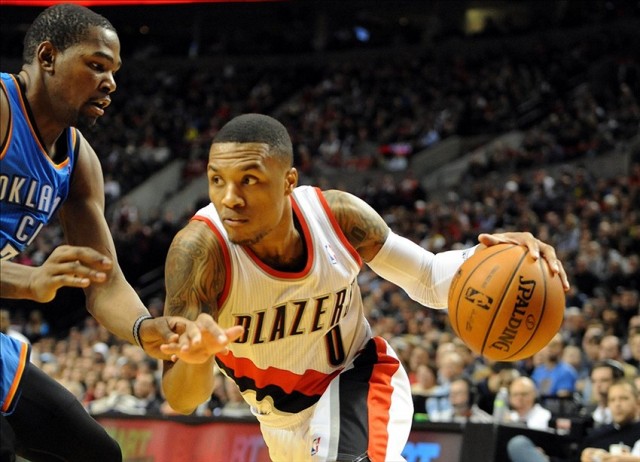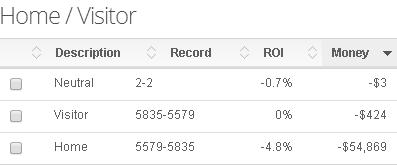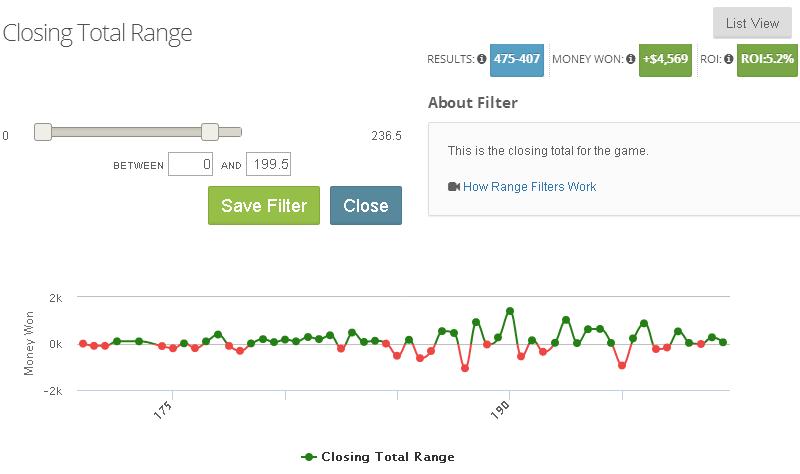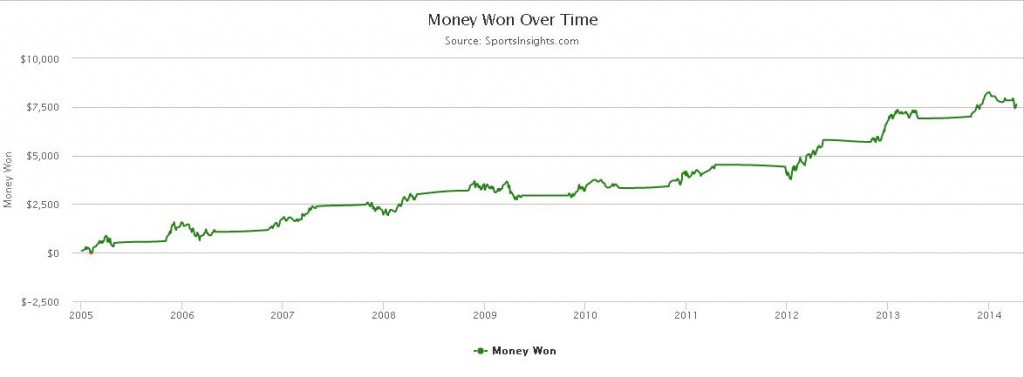
2014-15 NBA Betting Against the Public Report
Betting Against the Public is one of the most popular yet basic sports betting methods used here at Sports Insights. Our longstanding philosophy has been to see which side the public is loading up on by utilizing our public betting trends from seven contributing offshore sportsbooks, and then simply bet the other side.
You’ve heard the expression the house always wins? Betting against the public typically ensures that you’re on the same side as the house and has been a historically profitable strategy across all six major US sports.
Before the start of every season we reveal the optimal betting percentage threshold when betting against the public while trying to exploit the newest filters that have been added to our Bet Labs software.
Our first step in creating a winning contrarian system was to narrow our focus to solely road teams by selecting the “Home/Visitor” filter. As we’ve expressed many times, home field advantage is vastly overrated in every sport with the exception of baseball. To that point, NBA road teams have gone 5,835-5,579 ATS (-4.24 units) since the start of the 2005-06 season while betting all home teams over that period would have resulted in a loss of just over 548 units.
Once we had established a good starting point for our system, it was time to layer on our contrarian strategy by utilizing the “Spread %” filter. Although the most basic betting against the public strategy did not improve our system, we did find that the more lopsided the game was, the more our return on investment (ROI) increased.
Although the highest ROI correlates with visitors receiving less than 30% of spread bets, we will focus on teams receiving less than 35% of spread bets due to the significantly larger sample size and units won. We will also eliminate the 10 favorites fitting this criteria (4-6 ATS) by selecting underdogs from the “favorite/dog” filter.
While this basic system could be bet with confidence, there are two additional factors that I’ve long believed can be beneficial for NBA road dogs:
- Underdogs perform better in low-scoring games because it makes each point on the spread more valuable
- Underdogs perform better in conference games due to their familiarity with the opponent
To test these two theories, we wanted to focus on games with over/unders of less than 200 by utilizing our “closing total range” filter and by selecting conference from the “conference/non-conference filter. As you can see from the screenshot below, this increased our ROI from 4.2% to 5.2%.
While these results fell in line with expectations, the most staggering improvement came when we narrowed our focus to examine conference games. While non-conference games fitting these criteria have actually posted a losing record (169-185, -24.41 units), teams fitting this criteria have gone an incredible 306-222 for +70.1 units and a 13.3% ROI when playing a conference opponent. It’s also interesting to note that this system has been profitable during the postseason as well with a 22-15 record (+6.17 units) which brings the overall record to 328-237 ATS (+76.27 units).
The results graph depicted below shows that this system has been consistently profitable, with only one losing season (39-39 for -0.56 units in 2008-09) in the last decade. That record includes a 145-96 ATS record (+42.99 units) over the past four seasons. With consistent year-to-year results, a significant sample size, and a strong driving hypothesis, this system meets all three major characteristics of a winning betting system.
We offer a 6-day Bet Labs trial for anybody interested in creating their own winning NBA betting systems, but Pro customers have full access to our Best Bets and Bet Signals along with real-time odds, public betting trends and much more.
We’ve also introduced a new free NBA odds page where bettors can access odds, injuries, futures and other valuable information. Current Bet Labs customers can also copy this system from the Think Tank to receive all current game matches via e-mail or text message.
Have any questions for the staff at Sports Insights? Utilize our live chat to speak with a customer service representative or e-mail us at help@sportsinsights.com.
2/28/15 Update: This system has gone 14-2 ATS (+11.43 units) during the 2014-15 season and is now 346-244 ATS (+86.52 units) overall.




Matt
10/28/2014 at 2:58 pmSo the final records (328-237 ATS) included both additional filters? Under 200 total points AND conference game?
So in summation, the filters are:
1) road dogs receiving less than 35% ATS
2) total under 200
3) conference game
Is this correct?
Thank you!
David Solar
10/28/2014 at 3:09 pmThat’s correct. Those results include both regular season and playoff games and improve when looking at dogs of 10+ points.
Matt
10/28/2014 at 3:31 pmThank you sir!
Matt
10/28/2014 at 3:35 pmSorry, one last question.
It’s less than 35% and not 35% or less, correct?
So the exact number of 35% is not in play, correct?
David Solar
10/28/2014 at 3:45 pmCorrect. The spread percentage range is between 0 and 34 and does NOT include 35.
Chris
10/28/2014 at 5:25 pmWhen you say Conference do you mean division or East/West conference? Sorry just want to make sure I’m clear.
Thanks
David Solar
10/29/2014 at 8:19 amThat means it’s two conference opponents playing each other, so either two Eastern Conference teams or two Western Conference teams.
Matt
10/29/2014 at 1:54 pmAnother question I thought of:
How long do you wait for the percentages, lines, etc to settle in before making the play?
A total could start at 201 and end up at 199 an hour before game time and then a game that wasn’t a play earlier in the day now becomes one later in the day (if %’s match up as well)
David Solar
10/29/2014 at 2:09 pmWe utilize closing lines from Pinnacle and our closing public betting percentages for this system. In general, we’d recommend waiting until two hours or less before game time to place your bet. This ensures that we’ve accumulated enough information and that we avoid any dramatic changes to the public betting percentage.
Matt
10/29/2014 at 2:14 pmThank you! Last one I swear :) ….
Did you run this system with the same filters with HOME DOGS as well?
Curious to see how the results would compare. Thanks again
David Solar
10/29/2014 at 2:18 pmHome teams are overvalued in every sport with the exception of baseball. If we change this system to focus on home dogs fitting this criteria the system drops substantially and loses all profitability (ROI of -4.8%).
Matt
11/03/2014 at 11:04 amI said last one, but I can’t help myself haha.
I was wondering what the results were using the same parameters except without the filter of totals under 200? So instead it would be: road dog, <35%, conference game, any total.
So far there haven't been many games that fit the criteria listed in your article (only 1 by my calculations) so I'm curious to know the historic data with the new filters I stated above.
Thanks so much! Sorry for being a pest
Ben
11/13/2014 at 10:38 amHas this system been tested by parlaying the underdog with the under? Since the O/U is a factor into our system, I’m wondering if by parlaying with the under you might increase your ROI. Obviously the hit rate will go down, but the better odds from the correlation of the spread with the under might make it attractive.
David Solar
11/13/2014 at 1:59 pmIn general we recommend staying away from parlays. Instead, we would suggest flat betting where bettors have a unit size representing 2-4% of their total bankroll. Also, you should know that in games with high totals the under tends to be undervalued whereas the value is typically on the over in games with low totals. In fact, when the total is less than 200, the over has gone 3758-3710 (50.3%) since 2003. You have an interesting idea, but I would not recommend this strategy.
john bub
11/19/2014 at 8:54 pmCould you clarify for me how you calculate units won? I cant come up with 5.7 so obviously I’m not understanding the way it works. I get 5.9 thanks
David Solar
11/20/2014 at 1:49 pmWe use the closing lines from Pinnacle for the ATS record and units won on all Bet Labs systems and not all closings lines finish with -110 juice which is why our units earned may differ from your calculations.
john bub
11/20/2014 at 5:38 pmso the loss (atlanta +4 1/2 vs Toronto) was -130? I dispute that
David Solar
11/20/2014 at 5:46 pmAny loss will be minus one unit because we bet one unit on every game — not to win one unit.
john bub
11/20/2014 at 5:55 pmgot it thanks
Mark Fletcher
12/12/2014 at 6:47 amI understand the above but looking at today’s game do not understand the line movements. If I’m reading it correctly it seems to show that in the Charlotte – Memphis game the line started at MEM -10 and 89% of the money has gone on Memphis. However now the line is MEM -9.0. Surely if all the money is going on Memphis the line should have moved the other way. Looks like exactly the same scenario in the Indiana game which doesn’t make sense and suggests I’d have been better off betting the away underdog (Charlotte) at the earlier price before any market movement despite the market going against Charlotte?
David Solar
12/12/2014 at 2:01 pmThe percentage references the number of bets placed on each side, not the dollar amount. That means that although a majority of bettors are taking Memphis, there is actually more money being placed on Charlotte to cause that reverse line movement. Essentially, a number of uninformed/square bettors are taking Memphis -10, but big money from wise guys/betting syndicates has been taking Charlotte +10. This indicates that sharp money likes the underdog in this matchup.
DST
12/16/2014 at 9:01 amThere’s what you call public money and sharp money.
Public money is placed by the public, sharp money is placed by professionals.
You can have 100 people from the public place 1 unit each, meaning you would have 100 units on the first team, but 50 professionals can all bet 3 units each, meaning the first team would have 2/3 of the bets (100 out of 150), but would only have 40% of the money (100 units out of the possible 250).
Mike Lavallee
01/12/2015 at 9:40 amGood stuff guys!
David
01/22/2015 at 8:29 pmNew to sports insights and love the strategies on here, truly the best in the business. I jumped on the pacers last night as a system play here since I saw they met the criteria, even though I was hesitant because the 12-2 record ATS before last nights game seemed way above the normal ROI for this system.. Wish there was a prop on a Kyle Korver dunk..
Do you recommend to continue to follow this even though at 12-3 history would say this strategy has to level out based on previous performance?
Keep up the good work!
David Solar
01/22/2015 at 8:50 pmYes we would. We don’t anticipate that this system will continue winning at an 80% rate, but you shouldn’t expect a regression to the mean. We still believe this system has a positive expected value.
Also, Indiana did not end up finishing as a system match because they received 42% of spread bets.
David
01/22/2015 at 9:16 pmThank you for the quick reply.. I had been monitoring the % of bets throughout the afternoon and booked it at 5:30.. Do you recommend waiting till right before tipoff to make sure the action is still below 35%?
David Solar
01/22/2015 at 9:32 pmSince this system is based on the closing lines/betting percentages it’s best to wait until just before tip-off before placing your bet.
icecapper
01/01/2016 at 10:44 amAny update how this system finished out last year and how it’s doing this season? It seems like underdog lines are tighter than ever.